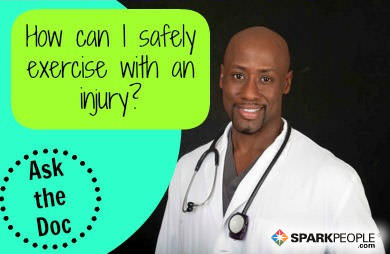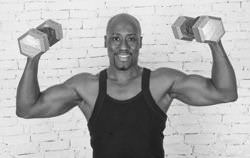
Aerobic exercise may seem impossible if you have a lower-body injury like an ankle sprain or tibia (leg) stress fracture, but I promise you—it’s possible. You may have to get a little creative though. Consider using the handlebar rowing machine, whereby you are upright with no stress on the injured extremity or joint. Another cardio exercise that is non-weight bearing for the lower extremity is swimming, which is a phenomenal way to give your joints a break and to maintain flexibility, endurance, and strength.
If you have an upper extremity injury, such has tennis elbow (lateral epicondylitis) or a boxer’s fracture (5th metacarpal fracture), it is now essential to focus on the lower extremities to train your heart. You can consider using the recumbent bike or walking speed laps in the pool. These activities avoid direct stress on the area under rehab. Also, if you have been placed in a cast, avoid getting it wet and minimize activities with excessive vibrational stress to the fractured limb which may cause the fracture (broken bone) to move.
Don’t forget to stretch.
When you have an injured area which is swollen and tender due to a sprain or strain, depending on the severity of the injury, gentle stretching along with ice on the area should decrease the inflammation in the area. Get the OK from your designated health care professional first, and then continue to stretch daily or take a seated stretchingclass![]() while you are recovering. Stretching is excellent for the joints, ligaments and tendons. Remember to continue to stretch the uninjured side of your body also to avoid imbalances that can lead to further injury. Remember to consult with your doctor about the contraindicated stretches for the impaired limb.
while you are recovering. Stretching is excellent for the joints, ligaments and tendons. Remember to continue to stretch the uninjured side of your body also to avoid imbalances that can lead to further injury. Remember to consult with your doctor about the contraindicated stretches for the impaired limb.
Be mindful of your calories.
What you eat will correlate in part to how quickly you recover from an injury. Your fast recovery will get you back to a paced and graduated![]() exercise program. I am a big advocate of “mindful eating,” which involves eating with balance and moderation in mind. This is especially important when you are recovering from an injury. If you continue to consume the same amount of calories (or more) during you rehab program, yet you’re moving less, you will most likely gain weight. Weight gain is an unwanted side effect that I see in many of my patients who simply eat more and forsake any aerobic conditioning during their rehab programs. Minimize any alcohol or sugary soda while your body is healing to optimize your healing potential. Continue to eat a variety of fresh fruits, nuts, vegetables and grains, and omega-3 rich foods, lean meats and some dairy. Tailor your rehab diet in a manner to avoid any foods which you may have an allergy or sensitivity.
exercise program. I am a big advocate of “mindful eating,” which involves eating with balance and moderation in mind. This is especially important when you are recovering from an injury. If you continue to consume the same amount of calories (or more) during you rehab program, yet you’re moving less, you will most likely gain weight. Weight gain is an unwanted side effect that I see in many of my patients who simply eat more and forsake any aerobic conditioning during their rehab programs. Minimize any alcohol or sugary soda while your body is healing to optimize your healing potential. Continue to eat a variety of fresh fruits, nuts, vegetables and grains, and omega-3 rich foods, lean meats and some dairy. Tailor your rehab diet in a manner to avoid any foods which you may have an allergy or sensitivity.
Focus on weight bearing exercises.
Lifting weights can be a tricky proposition during an injury. Just remember if the upper body is injured, you can probably safely work the lower body. I recommend using the weight machines. If you have a wrist fracture or rotator cuff injury of the shoulder, for example, you can still use the leg press machine, hamstring curl machine, leg extension machine and/or calf raise machine. These exercises place no stress on the upper body and you simply have to place the pin at the desired weight, without lifting any free weights. If you have a knee or hip injury, consider using the machines for upper body conditioning such as biceps curls, triceps push-downs or bench press (flat, inclined, or declined). The sky is the limit for diversifying your workout with the machines, even when injured. Remember weight bearing activities can stave off the effects of osteoporosis also.
Talk with your health care team regularly.
It is critical that you are compliant and listen to your health care rehab team. I do not recommend simply treating yourself after the health care professionals lay out a comprehensive rehab protocol. Compliance is critical to a speedy recovery. I do suggest discussing any alternative treatments that you may want to utilize with them before you simply do it on your own. This may cause greater injury and delay your recovery. Consider getting a second opinion also. And remember to ask lots of questions. For you to find out exactly what is safe (what activities, intensities, frequencies and durations of exercise), you probably have to do a lot of the talking. Ask questions and get the clarity you need at each appointment so that you’re not left wondering about it for weeks, missing day after day from exercise.
Rest, rest, rest.
The body recovers better from injury when it’s not undergoing a lot of stress. Stress-producing hormones can affect our sleep patterns and our speed of recovery. Sleep is an essential component of healing the body. So get plenty of sleep and continue to incorporate rest and recovery days in your weekly workout plan.
Meditate.
Meditation is a great way to enrich your holistically healthy lifestyle. I recommend dailymeditation for 15 -20 minutes to decrease stress, promote healing and to visualize a healed, happy magnificent body and life. A fit mind helps to create a healthy and strong body. Sit quietly. Visualize yourself fully recovered from your injury or accident. See your body healed and active again. Mediation is a fantastic way to improve your mindset about healing and creating an awesome body.
As always, consult with your health care team before using the aforementioned tips to make sure they are appropriate for you and your injury.
Keep on exercising! Exercise is life!
Have you ever struggled with maintaining a fitness program while injured? What did you learn from the experience?
 About the Author
About the Author
Dr. Levi Harrison, MD, physician, orthopedic surgeon and fitness expert, earned his Medical degree at The University![]() of California at Davis School of Medicine. His Los Angeles-based practice is the center of excellence for sports-related upper extremity and shoulder injuries as well as hand rehabilitation, repetitive motion work related injuries, and restorative hand function procedures. In addition to being an avid sports enthusiast, fitness expert, motivational speaker and philanthropist, he hosts a weekly radio show on LA Talk radio. He is the author of “The Art of Fitness” (Brio Press, 2012), a thorough collection of exercises he developed to help others achieve an active, healthy lifestyle.
of California at Davis School of Medicine. His Los Angeles-based practice is the center of excellence for sports-related upper extremity and shoulder injuries as well as hand rehabilitation, repetitive motion work related injuries, and restorative hand function procedures. In addition to being an avid sports enthusiast, fitness expert, motivational speaker and philanthropist, he hosts a weekly radio show on LA Talk radio. He is the author of “The Art of Fitness” (Brio Press, 2012), a thorough collection of exercises he developed to help others achieve an active, healthy lifestyle.

